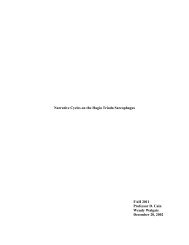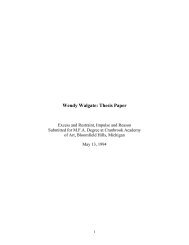contemporary clay sculpture - Wendy Walgate
contemporary clay sculpture - Wendy Walgate
contemporary clay sculpture - Wendy Walgate
Create successful ePaper yourself
Turn your PDF publications into a flip-book with our unique Google optimized e-Paper software.
Barbro Åberg<br />
The distinctive works of Barbro Åberg are imbued<br />
with a life of their own. They tell tales of<br />
ancient cultures and common human dreams.<br />
Their powerful symbolism wakes collective<br />
memories of early beginnings, of the passing of time,<br />
and of eternity, in a<br />
collage of glimpses<br />
of life.<br />
The works are not<br />
easily categorized. A<br />
Swede living in Denmark,<br />
Åberg manages<br />
to escape the shackles<br />
of both traditions,<br />
borrowing the best<br />
from each: the playful<br />
evocativeness of the<br />
Swedes and the rigorous<br />
analytical approach<br />
of the Danes.<br />
In addition, she spent<br />
five years in the<br />
United States at the<br />
outset of her career;<br />
a period that still inspires<br />
her works with<br />
a sense of confidence<br />
and adventure. It is<br />
in this amalgam of<br />
cultures—in this field<br />
of tension—that her<br />
works exist.<br />
“A recurrent theme<br />
in my work is a kind<br />
of search for the universal,”<br />
says Åberg. “My work is not private. Of course I<br />
am an ingredient in the work. And the intensity of the work<br />
process is reflected in the work. If I wasn’t really present,<br />
you can tell by the finished work. Then, it’s of less consequence.<br />
A good piece has its own language, its own story.<br />
It’s alive somehow.”<br />
Åberg’s work has various references. One is ancient<br />
scripts. She models Phoenician or runic inscriptions in three<br />
by Ulla Munck Jørgensen<br />
dimensions and in the process transforms her content to a<br />
more abstract result that merely hints at its origins.<br />
Once, the result was so reminiscent of old navigational<br />
instruments or astronomical devices that a new theme spontaneously<br />
developed. Based on the original drawings of the<br />
sixteenth-century<br />
Danish astronomer,<br />
Tycho Brahe, she<br />
has created a series<br />
of works inspired<br />
by early astronomical<br />
instruments.<br />
The cells of life<br />
are another reference.<br />
A recent piece,<br />
“Black Egg,” is a<br />
large sculptural rendition<br />
of a group of<br />
cells. Maybe a piece<br />
of human tissue<br />
magnified under the<br />
microscope. Or the<br />
cells of a beehive<br />
or a cut-through<br />
mushroom. The archetypal<br />
symbols of<br />
life are translated<br />
into <strong>clay</strong>, the very<br />
essence of renewal<br />
of life fossilized,<br />
forever unchangeable<br />
in an unset-<br />
tling contradiction<br />
of meaning.<br />
The ship is an ongoing<br />
motif that first appeared in her work when she was at<br />
art school. “As a child, I had a recurring dream about being<br />
a passenger on a large passenger ship,” Åberg explains. “I<br />
was there with a boy of my own age and many other people.<br />
We wanted to go and watch the sunset, and as we went<br />
out onto the deck, we saw that we were inside a grotto and<br />
that the ship was in fact a huge rock.” Yet another example<br />
of the duality of form and multiplicity of reference that<br />
Spiral Wheel, 60 cm (24 in.) in diameter, ball <strong>clay</strong> with perlite and paper fibers, with white terra sigillata and<br />
stains, fired to 1135˚C (2075˚F) in an electric kiln, 2005.<br />
www.ceramicartsdaily.org | Copyright © 2009, Ceramic Publications Company | Contemporary Clay Sculpture | 9





